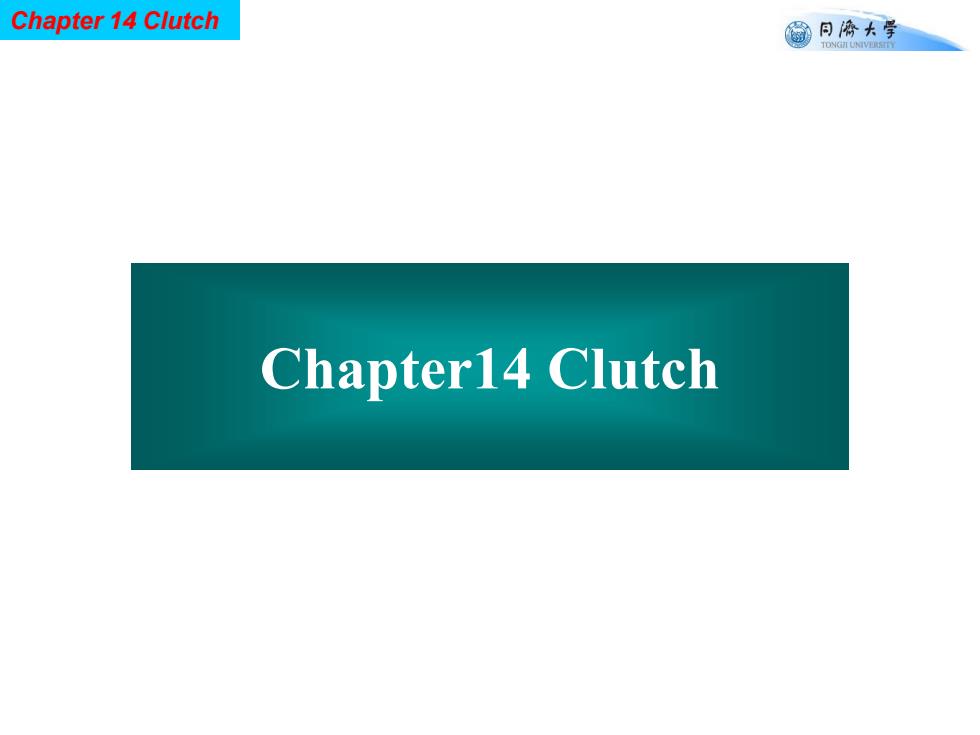
Chapter 14 Clutch 同©大学 TONGII UNIVERSTTY Chapter14 Clutch
Chapter 14 Clutch Chapter14 Clutch
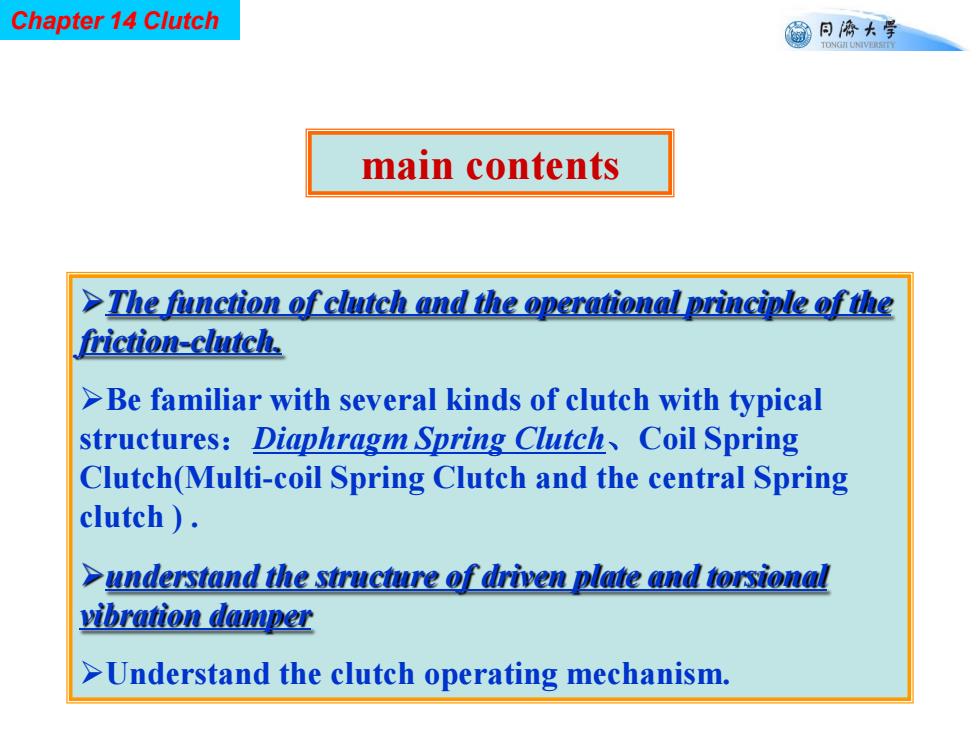
Chapter 14 Clutch 窗月桥大学 TONGII UNIVERSTTY main contents >The function of clutch and the operational principle ofthe friction-clutch. >Be familiar with several kinds of clutch with typical structures:Diaphragm Spring Clutch Coil Spring Clutch(Multi-coil Spring Clutch and the central Spring clutch ) >understand the structure of driven plate and torsional vibration damper >Understand the clutch operating mechanism
Chapter 14 Clutch main contents The function of clutch and the operational principle of the friction-clutch. Be familiar with several kinds of clutch with typical structures:Diaphragm Spring Clutch、Coil Spring Clutch(Multi-coil Spring Clutch and the central Spring clutch ) . understand the structure of driven plate and torsional vibration damper Understand the clutch operating mechanism
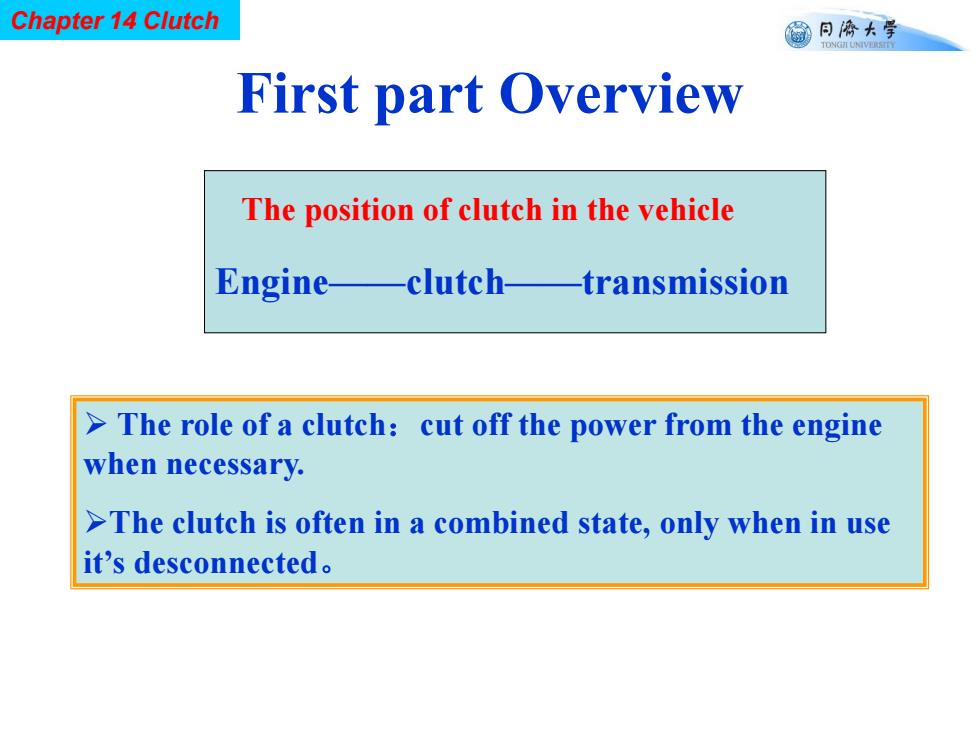
Chapter 14 Clutch 窗月桥大学 TONGII UNIVERSTTY First part Overview The position of clutch in the vehicle Engine-clutch- transmission >The role of a clutch:cut off the power from the engine when necessary. >The clutch is often in a combined state,only when in use it's desconnected
Chapter 14 Clutch First part Overview The role of a clutch:cut off the power from the engine when necessary. The clutch is often in a combined state, only when in use it’s desconnected。 The position of clutch in the vehicle Engine——clutch——transmission

Chapter 14 Clutch 日儕大学 TONGII UNIVERSTTY The work characteristics of clutch under various working conditions Transmission in neutral a.Start working Clutch in combination condition At the minimum stable speed clutch Start the engine to idling condition The function of clutch:1.Ensure the aged state car start smoothly Gradually release the clutch pedal and Clutch gradually into the The engine under combined state the minimum stable Step on the accelerator speed Dedal Clutch in combined state flameout Finish the start
Chapter 14 Clutch The work characteristics of clutch under various working conditions a. Start working condition Clutch in combination At the minimum stable speed The clutch is disengaged state Clutch gradually into the combined state Clutch in combined state Transmission in neutral Start the engine to idling condition Step on the clutch Hanging 1 position Gradually release the clutch pedal and Step on the accelerator pedal Finish the start Hanging 1 position directly Cause Instantaneous impact The engine under the minimum stable speed flameout If there is no clutch The function of clutch:1.Ensure the car start smoothly

Chapter 14 Clutch 日儕大学 TONGII UNIVERSTTY The work characteristics of clutch under various working conditions b.Shifting working Run in X position Clutch in combination condition clutch Step on the clutch and Clutch in disengaged state Shifting The driven gear can achieve The function of a clutch: to the 2.Ensure smooth shift work Damage to the drive Finish the shifting Clutch in combined state components
Chapter 14 Clutch b. Shifting working condition Clutch in combination The driven gear can achieve synchronization Clutch in disengaged state Clutch go gradually into the combined state Clutch in combined state Run in X position Step on the clutch and Shifting Gradually release the clutch pedal Finish the shifting engage a gear directly Have a great impact Damage to the drive components If there is no clutch The function of a clutch: 2.Ensure smooth shift work The work characteristics of clutch under various working conditions
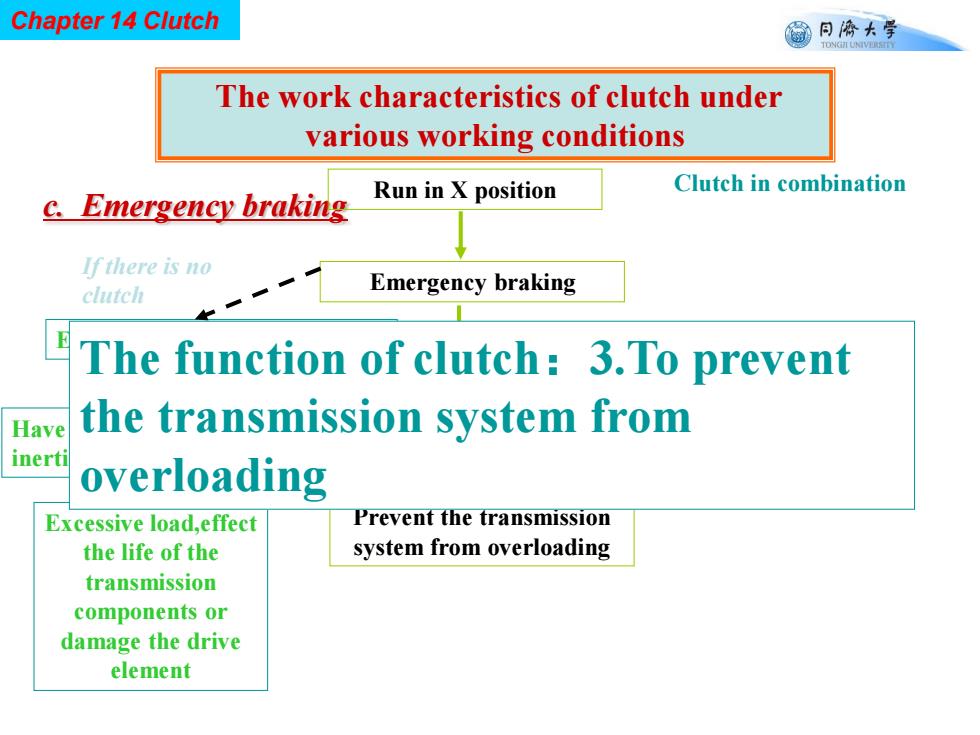
Chapter 14 Clutch 日儕大学 TONGII UNIVERSTTY The work characteristics of clutch under various working conditions Run in X position Clutch in combination c.Emergency braking If there is no clutch Emergency braking The function of clutch:3.To prevent Have the transmission system from inerti overloading Excessive load,effect Prevent the transmission the life of the system from overloading transmission components or damage the drive element
Chapter 14 Clutch c. Emergency braking Clutch in combination Clutch trackslip Run in X position Emergency braking The force between the driving disc and the driven disc reachs the limit Prevent the transmission system from overloading Engine speed decreases sharply Have a great moment of inertia Excessive load,effect the life of the transmission components or damage the drive element If there is no clutch The function of clutch:3.To prevent the transmission system from overloading The work characteristics of clutch under various working conditions
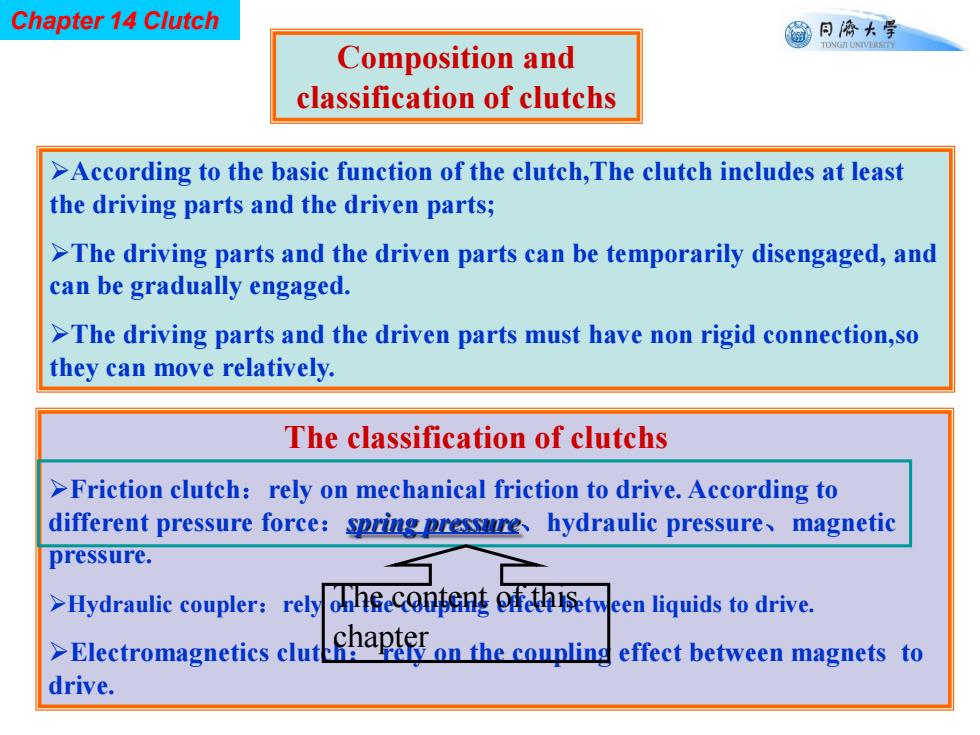
Chapter 14 Clutch 圆日海大学 TONGII UNIVERSTTY Composition and classification of clutchs >According to the basic function of the clutch,The clutch includes at least the driving parts and the driven parts; >The driving parts and the driven parts can be temporarily disengaged,and can be gradually engaged. >The driving parts and the driven parts must have non rigid connection,so they can move relatively. The classification of clutchs >Friction clutch:rely on mechanical friction to drive.According to different pressure force:spring pressure hydraulic pressure magnetic pressure. Hydraulic coupler:rely onetween liquids to drive. Electromagnetics clut on the coupling effect between magnets to drive
Chapter 14 Clutch Composition and classification of clutchs According to the basic function of the clutch,The clutch includes at least the driving parts and the driven parts; The driving parts and the driven parts can be temporarily disengaged, and can be gradually engaged. The driving parts and the driven parts must have non rigid connection,so they can move relatively. The classification of clutchs Friction clutch:rely on mechanical friction to drive. According to different pressure force:spring pressure、hydraulic pressure、magnetic pressure. Hydraulic coupler:rely on the coupling effect between liquids to drive. Electromagnetics clutch: rely on the coupling effect between magnets to drive. The content of this chapter
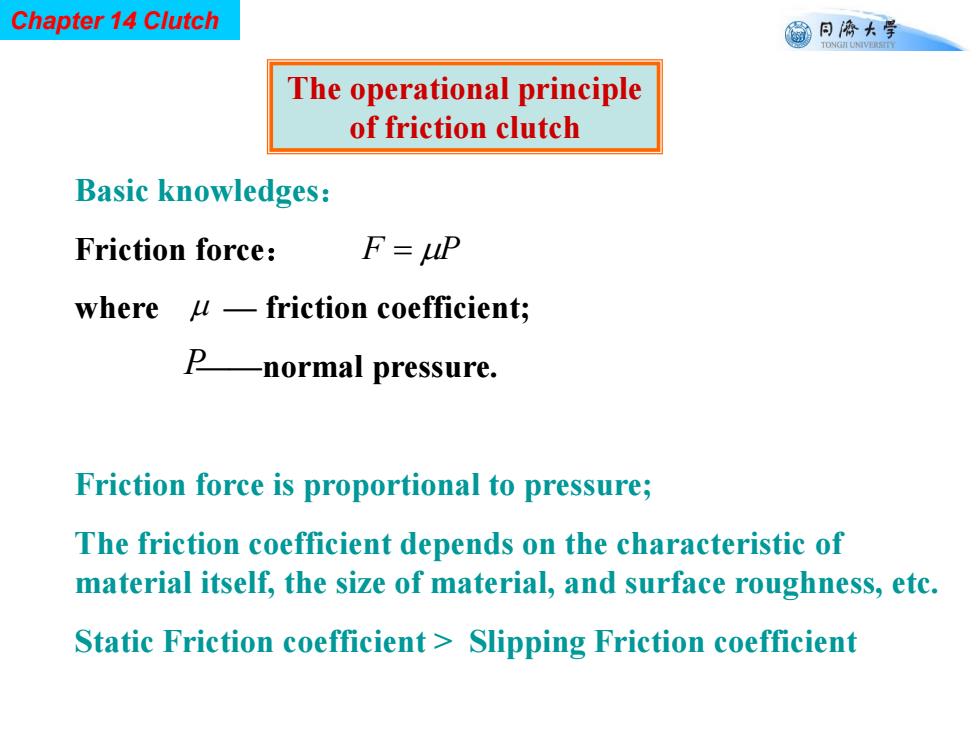
Chapter 14 Clutch 月傍大学 TONGII UNIVERSITY The operational principle of friction clutch Basic knowledges: Friction force: F=uP where u-friction coefficient; Pnormal pressure. Friction force is proportional to pressure; The friction coefficient depends on the characteristic of material itself,the size of material,and surface roughness,etc. Static Friction coefficient Slipping Friction coefficient
Chapter 14 Clutch The operational principle of friction clutch Basic knowledges: Friction force: where — friction coefficient; ——normal pressure. Friction force is proportional to pressure; The friction coefficient depends on the characteristic of material itself, the size of material, and surface roughness, etc. Static Friction coefficient > Slipping Friction coefficient F P P

Chapter 14 Clutch 日儕大学 TONGII UNIVERSTTY The operational principle of friction clutch .nnla4n The composition of clutch: >Driving part,driven part,pressure mechanism operation mechanism; >The function of the driving part,driven part and pressure mechanism is to ensure the clutch in the engaged state and transfer power/torque; >The operation mechanism (release mechanism) can ensure the clutch be disengaged correctly. Pedal stop pin Spline 图i5-l唯擦离合器的工作原理和Shaft 1-飞轮;2-从动盘;3-踏板:4-压紧弹簧:5-从动轴:6从动盘镘
Chapter 14 Clutch The operational principle of friction clutch Flywheel Driven plate Pedal spring Driven shaft Hub of driven plate Engine shaft Spline Shaft Pedal stop pin The composition of clutch: Driving part、driven part、pressure mechanism、 operation mechanism; The function of the driving part, driven part and pressure mechanism is to ensure the clutch in the engaged state and transfer power/torque; The operation mechanism (release mechanism) can ensure the clutch be disengaged correctly

Chapter 14 Clutch 同©大学 TONGII UNIVERSTTY The operational principle of friction clutch Clutch pedal Clutch Flywheel cover Pressure Plate Diaphragm Driven spring plate Engage and disengage state of friction clutch
Chapter 14 Clutch Flywheel Driven plate Diaphragm spring Clutch cover Pressure Plate Clutch pedal Engage and disengage state of friction clutch The operational principle of friction clutch